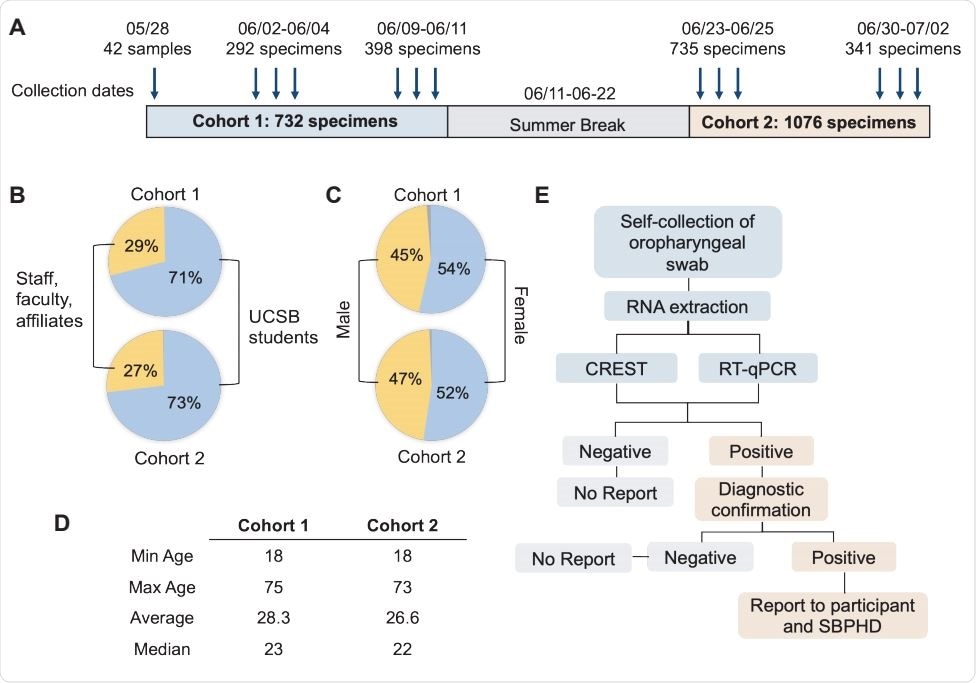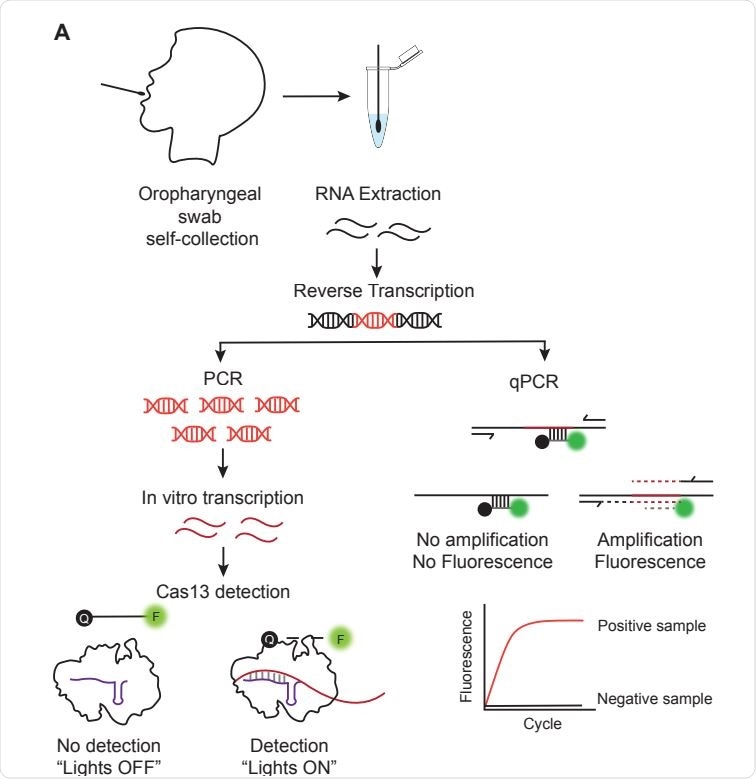A recent US study available on the medRxiv* preprint server supports the use of self-collected oropharyngeal swabs, together with CRISPR- and PCR-based diagnostic assays, as rapid, feasible and reliable approach for the surveillance of severe acute respiratory syndrome coronavirus 2 (SARS-CoV-2) in university students and other asymptomatic individuals.
.jpg)
Study: CRISPR-based and RT-qPCR surveillance of SARS-CoV-2 in asymptomatic individuals uncovers a shift in viral prevalence among a university population. Image Credit: Nathan Devery / Shutterstock

 This news article was a review of a preliminary scientific report that had not undergone peer-review at the time of publication. Since its initial publication, the scientific report has now been peer reviewed and accepted for publication in a Scientific Journal. Links to the preliminary and peer-reviewed reports are available in the Sources section at the bottom of this article. View Sources
This news article was a review of a preliminary scientific report that had not undergone peer-review at the time of publication. Since its initial publication, the scientific report has now been peer reviewed and accepted for publication in a Scientific Journal. Links to the preliminary and peer-reviewed reports are available in the Sources section at the bottom of this article. View Sources
The relentless progress of the coronavirus disease (COVID-19) pandemic profoundly impacted the health of communities around the globe and resulted in tectonic shifts regarding the professional, educational, and social aspects of our daily lives.
An essential aspect of pandemic control is the meticulous planning for the return to college campuses on the brink of the 2020-2021 academic year. And while COVID-19 testing has thus far concentrated on elderly and more fragile patients with an increased risk of dying, a substantial burden of disease has emerged among those attending colleges and universities.
Likewise, this large asymptomatic population reservoir can serve as a vector, sparking new disease pockets and additional outbreaks. Consequently, early detection of the infection in people with mild or non-existent COVID-19 symptoms is pivotal for preventing hidden outbreaks.
Such potential of stealth transmission is especially significant for university communities, where off-campus residences, dormitories, and social spaces with high occupation densities favor the rapid spread of respiratory diseases.
This is why researchers from the University of California Santa Barbara, Santa Barbara Cottage Hospital, and Pacific Diagnostic Laboratories in the US decided to utilize a CRISPR-based test to screen for SARS-CoV-2 in asymptomatic individuals belonging to the university community in order to improve our understanding of disease prevalence and its trajectory.

Description of the study and population demographics. (A) 1,808 persons were recruited in two cohorts during the months of May, June and July of 2020. The arrows indicate the days of sample collection. Samples were not collected during the UCSB summer break from June 11 to June 22. (B, C, D). UCSB affiliation, gender and age of study participants. (E) Flow chart of specimen handling (SBPHD Santa Barbara Public Health Department). Only positive results, confirmed in a CLIA laboratory with diagnostic testing, were reported to the participants and the Santa Barbara Public Health Department (SBPHD).
A surveillance study with two diagnostic assays
To obtain better insights on the SARS-CoV-2 spread patterns in their local community, the researchers enrolled 1,808 healthy volunteers in the surveillance study. First, they aimed to establish the exact prevalence of asymptomatic SARS-CoV-2 infection rates on a university campus in California.
Then they have sought to appraise the changes in viral prevalence that are associated with the varying community conditions related to non-pharmaceutical interventions. Finally, they wanted to compare and contrast the performance of CRISPR- and PCR-based diagnostic assays for large-scale virus surveillance sampling in COVID-19 asymptomatic individuals.
Oropharyngeal samples used in the study were self-collected and processed for parallel SARS-CoV-2 testing with the use of a newly developed CRISPR-based assay (known as CREST) and the reverse transcription-polymerase chain reaction (RT-qPCR) assay recommended by the US Centers for Disease Control and Prevention (CDC).
The researchers compared the results obtained from two distinct time periods. The first collection period ensued during May and June 2020, which was approximately two months into a US state-wide stay-at-home directive.
The second collection period took place during late June and early July 2020, roughly three weeks after local restrictions for isolation were abandoned, and the community was authorized to enter the third stage of a scheduled four-stage reopening.

Overview of CREST and RT-qPCR protocols. (A) OP swabs were self-collected by participants and RNA was isolated from the samples. For CREST, RNA was reversed transcribed, and the resulting DNA was amplified by polymerase chain reaction (PCR) using primers for the N1, N2, and RNAse P target regions. The amplified region of interest was transcribed in vitro and used as the template for detection by Cas13. The activation of Cas13 following target recognition by the guide RNA (gRNA) was measured using a fluorescent poly-U cleavage reporter. For qPCR, the RNA was reverse transcribed and detected by real-time amplification.
RT-qPCR and CREST in harmony
This study has shown that there were no COVID-19 cases among the tested individuals in May and June 2020. However, by using the same methods, the researchers demonstrated a substantial shift in prevalence approximately one month later, coincidental with changes in public interactions and community restrictions.
Such an increase in prevalence in a young and asymptomatic population (which would otherwise elude COVID-19 testing) suggested the leading wave of a local outbreak and corresponded with the rising number of cases in the surrounding county and the state of California.
Moreover, taking the study population as a whole, the estimated prevalence of the virus (calculated using the confirmed cases) was 0.74%. Also, there was an almost perfect agreement in both positive and negative results obtained by RT-qPCR and CREST, with a single exception.
"Our data support that self-sampling by oropharyngeal swab is dependable, and thus provides an alternative method for unsupervised or remotely supervised sample acquisition outside of a healthcare setting", emphasize study authors in their medRxiv paper.
Towards population-level asymptomatic screening
The primary challenge for university communities is the possibility of covert infections prompted by social and academic gatherings, which are otherwise inevitable in the context of a vibrant university campus.
"Our results substantiate that large, population-level asymptomatic screening using self-collection may be a feasible and instructive aspect of the public health approach within large campus communities," emphasize study authors.
And indeed, virtually perfect concordance between CRISPR- and PCR-based diagnostic assays can be considered as expanded options for SARS-CoV-2 surveillance testing in asymptomatic individuals.
In a nutshell, monitoring the population to unveil COVID-19 cases before they result in actual outbreaks could be regarded as a paramount mitigation approach within large campus communities and those facing similar challenges.

 This news article was a review of a preliminary scientific report that had not undergone peer-review at the time of publication. Since its initial publication, the scientific report has now been peer reviewed and accepted for publication in a Scientific Journal. Links to the preliminary and peer-reviewed reports are available in the Sources section at the bottom of this article. View Sources
This news article was a review of a preliminary scientific report that had not undergone peer-review at the time of publication. Since its initial publication, the scientific report has now been peer reviewed and accepted for publication in a Scientific Journal. Links to the preliminary and peer-reviewed reports are available in the Sources section at the bottom of this article. View Sources
Article Revisions
- Mar 23 2023 - The preprint preliminary research paper that this article was based upon was accepted for publication in a peer-reviewed Scientific Journal. This article was edited accordingly to include a link to the final peer-reviewed paper, now shown in the sources section.